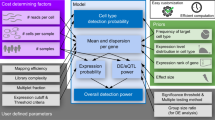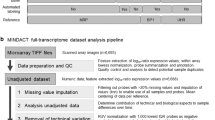Abstract
Microarray expression profiling is instrumental to our understanding of the function of the genome. Resolution of functionally relevant expression patterns will require the analysis of large data sets compiled from multiple investigators. For this and other reasons, I argue that it is crucial for array data to be publicly shared in a format as close to the 'raw data' as possible. Issues such as protection of intellectual property, ensuring quality of the data, and the format and timing for sharing array data are also discussed.
This is a preview of subscription content, access via your institution
Access options
Subscribe to this journal
Receive 12 print issues and online access
$189.00 per year
only $15.75 per issue
Buy this article
- Purchase on Springer Link
- Instant access to full article PDF
Prices may be subject to local taxes which are calculated during checkout



Similar content being viewed by others
References
Iyer, V. R. et al. The transcriptional program in the response of human fibroblasts to serum. Science 283, 83–87 (1999).
Hughes, T. R. et al. Functional discovery via a compendium of expression profiles. Cell 102, 109–126 (2000).
Thibault, C. et al. Expression profiling of neural cells reveals specific patterns of ethanol-responsive gene expression. Mol. Pharmacol. 58, 1593–1600 (2000).
Golub, T. R. et al. Molecular classification of cancer: class discovery and class prediction by gene expression monitoring. Science 286, 531–537 (1999).
Lewohl, J. M. et al. Gene expression in human alcoholism: microarray analysis of frontal cortex. Alcohol Clin. Exp. Res. 24, 1873–1882 (2000).
Perou, C. M. et al. Molecular portraits of human breast tumours. Nature 406, 747–752 (2000).
Raychaudhuri, S., Sutphin, P. D., Chang, J. T. & Altman, R. B. Basic microarray analysis: grouping and feature reduction. Trends Biotechnol. 19, 189–193 (2001).
Brown, M. P. et al. Knowledge-based analysis of microarray gene expression data by using support vector machines. Proc. Natl Acad. Sci. USA 97, 262–267 (2000).
Dudoit, S., Yang, Y. H., Callow, M. J. & Speed, T. J. Statistical Methods for Identifying Differentially Expressed Genes in Replicated cDNA Microarray Experiments. Technical Report 578, Stanford Univ. School of Medicine (2000).
Li, C. & Wong, W. H. Model-based analysis of oligonucleotide arrays: expression index computation and outlier detection. Proc. Natl Acad. Sci. USA 98, 31–36 (2001).
Yue, H. et al. An evaluation of the performance of cDNA microarrays for detecting changes in global mRNA expression. Nucleic Acids Res. 29, E41 (2001).
Tusher, V. G., Tibshirani, R. & Chu, G. Significance analysis of microarrays applied to the ionizing radiation response. Proc. Natl Acad. Sci. USA 98, 5116–5121 (2001).
Lee, M. L., Kuo, F. C., Whitmore, G. A. & Sklar, J. Importance of replication in microarray gene expression studies: statistical methods and evidence from repetitive cDNA hybridizations. Proc. Natl Acad. Sci. USA 97, 9834–9839 (2000).
Toronen, P., Kolehmainen, M., Wong, G. & Castren, E. Analysis of gene expression data using self-organizing maps. FEBS Lett. 451, 142–146 (1999).
Eisen, M. B., Spellman, P. T., Brown, P. O. & Botstein, D. Cluster analysis and display of genome-wide expression patterns. Proc. Natl Acad. Sci. USA 95, 14863–14868 (1998).
Sherlock, G. Analysis of large-scale gene expression data. Curr. Opin. Immunol. 12, 201–205 (2000).
Jenssen, T. K., Laegreid, A., Komorowski, J. & Hovig, E. A literature network of human genes for high-throughput analysis of gene expression. Nature Genet. 28, 21–28 (2001).
Acknowledgements
I would like to thank all the members of the Miles laboratory for their enthusiasm, dedication and many helpful discussions. In particular, I thank Li Zhang for stimulating discussions regarding the analysis of microarray data. I also would like to acknowledge support from the National Institute on Alcohol Abuse and Alcoholism, the National Institute on Drug Abuse and the State of California, through a grant to the University of California for research on alcoholism and drug abuse.
Author information
Authors and Affiliations
Related links
Related links
FURTHER INFORMATION
Rights and permissions
About this article
Cite this article
Miles, M. Microarrays: lost in a storm of data?. Nat Rev Neurosci 2, 441–443 (2001). https://doi.org/10.1038/35077582
Issue Date:
DOI: https://doi.org/10.1038/35077582
This article is cited by
-
Domain-Specific Data Sharing in Neuroscience: What Do We Have to Learn from Each Other?
Neuroinformatics (2008)
-
Mobilizing the base of neuroscience data: the case of neuronal morphologies
Nature Reviews Neuroscience (2006)
-
Standardizing global gene expression analysis between laboratories and across platforms
Nature Methods (2005)
-
Software and methods for oligonucleotide and cDNA array data analysis
Genome Biology (2002)
-
Complex-trait genetics: emergence of multivariate strategies
Nature Reviews Neuroscience (2002)



